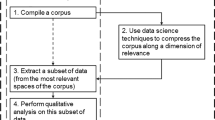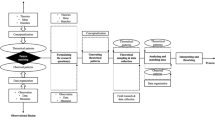Abstract
Events, routinely broadcasted by news media all over the world, are captured and get recorded to event databases in standardized formats. This wealth of information can be aggregated and get visualized with several ways, to result in alluring illustrations. However, existing aggregation techniques tend to consider that events are fragmentary, or that they are part of a strictly sequential chain. Nevertheless, events’ occurrences may appear with varying structures (i.e., others than sequence), reflecting elements of a larger, implicit process. In this work, we propose a methodology that will support analysts to get richer insights from event datasets by enabling a process perspective. Through a case study about a political phenomenon, we provide concrete recommendations on data reviewing, process discovery, and visually facilitated interpretations. We furthermore discuss the methodological and epistemological aspects that are needed to make our approach applicable for event analytics.





Similar content being viewed by others
References
Aalen O, Borgan O, Gjessing H (2008) Survival and event history analysis: a process point of view. Springer, Berlin
Adriansyah A, Buijs JCAM (2012) Mining process performance from event logs: the BPI challenge 2012. Case Study BPM Center Report BPM-12-15. BPMcenter.org
Best RH, Carpino C, Crescenzi MJ (2013) An analysis of the TABARI coding system. Confl Manag Peace Sci 30(4):335–348
Bose RJC, van der Aalst WM (2009) Context aware trace clustering: towards improving process mining results. In: SDM, SIAM, pp 401–412
Bose RJC, van der Aalst WM (2012) Process diagnostics using trace alignment: opportunities, issues, and challenges. Information Systems 37(2):117–141 (Management and engineering of process-aware information systems)
Broström G (2012) Event history analysis with R. CRC Press, Boca Raton
Celonis (2017) Academic cloud. https://academiccloud.celonis.com. Accessed 25 Sept 2017
Ching WK, Huang X, Ng MK, Siu TK (2013) Higher-order markov chains. Springer, Boston, pp 141–176
De Leoni M, van der Aalst WM, Dees M (2014) A general framework for correlating business process characteristics. In: International conference on business process management, Springer, pp 250–266
Delias P, Kazanidis I (2017) Process analytics through event databases: potentials for visualizations and process mining. In: Linden I, Liu S, Colot C (eds) Decision support systems VII. Data, information and knowledge visualization in decision support systems, vol 282, Springer International Publishing, Cham, pp 88–100. https://doi.org/10.1007/978-3-319-57487-5_7
Delias P, Doumpos M, Matsatsinis N (2015a) Business process analytics: a dedicated methodology through a case study. EURO J Decis Process 3(3–4):357–374. https://doi.org/10.1007/s40070-015-0050-4
Delias P, Grigori D, Mouhoub ML, Tsoukias A (2015b) Discovering characteristics that affect process control flow. In: Decision support systems IV—information and knowledge management in decision processes, Springer, pp 51–63
Fails JA, Karlson A, Shahamat L, Shneiderman B (2006) A visual interface for multivariate temporal data: finding patterns of events across multiple histories. In: 2006 IEEE symposium on visual analytics science and technology, IEEE, pp 167–174
Galili T (2015) dendextend: an R package for visualizing, adjusting, and comparing trees of hierarchical clustering. Bioinformatics 31:3718–3720
Gerner DJ, Schrodt PA, Francisco RA, Weddle JL (1994) Machine coding of event data using regional and international sources. Int Stud Q 38(1):91–119
Gerner DJ, Schrodt PA, Yilmaz O, Abu-Jabr R (2002) Conflict and mediation event observations (cameo): a new event data framework for the analysis of foreign policy interactions. International Studies Association, New Orleans
Glaser BG (1978) Theoretical sensitivity: advances in the methodology of grounded theory. Sociology Press, Mill Valley (oCLC: 926199357)
Gotz D, Stavropoulos H (2014) DecisionFlow: visual analytics for high-dimensional temporal event sequence data. IEEE Trans Vis Comput Graph 20(12):1783–1792
Gotz D, Wongsuphasawat K (2012) Interactive intervention analysis. In: AMIA annual symposium proceedings, American Medical Informatics Association, Washington, DC, USA 2012, pp 274–280
Gotz D, Wang F, Perer A (2014) A methodology for interactive mining and visual analysis of clinical event patterns using electronic health record data. J Biomed Inf 48:148–159
Günther CW, Rozinat A, van der Aalst WM (2009) Activity mining by global trace segmentation. In: International conference on business process management, Springer, pp 128–139
Gupta A, Jain R (2011) Managing event information: modeling, retrieval, and applications. Synth Lect Data Manag 3(4):1–141
Jiang L, Mai F (2014) Discovering bilateral and multilateral causal events in GDELT. In: International conference on social computing, behavioral-cultural modeling, and prediction
Keertipati S, Savarimuthu BTR, Purvis M, Purvis M (2014) Multi-level analysis of peace and conflict data in GDELT. In: Proceedings of the MLSDA 2014 2nd workshop on machine learning for sensory data analysis, ACM, p 33
Kwak H, An J (2016) Two tales of the world: Comparison of widely used world news datasets GDELT and EventRegistry. arXiv preprint arXiv:1603.01979
Leetaru K, Schrodt PA (2013) GDELT: global data on events, location and tone, 1979–2012. resreport, International Studies Association, Graduate School of Library and Information Science, University of Illinois at Urbana-Champaign, Champaign, USA. http://data.gdeltproject.org/documentation/ISA.2013.GDELT.pdf. Accessed 25 Sept 2017
Liu Z, Wang Y, Dontcheva M, Hoffman M, Walker S, Wilson A (2017) Patterns and sequences: interactive exploration of clickstreams to understand common visitor paths. IEEE Trans Vis Comput Graph 23(01):321–330
Maggi FM, Mooij AJ, van der Aalst WM (2011) User-guided discovery of declarative process models. In: 2011 IEEE symposium on computational intelligence and data mining (CIDM), IEEE, pp 192–199
Mannhardt F, de Leoni M, Reijers HA, van der Aalst WM, Toussaint PJ (2016) From low-level events to activities-a pattern-based approach. In: International conference on business process management, Springer, pp 125–141
Martjushev J, Bose RJC, van der Aalst WM (2015) Change point detection and dealing with gradual and multi-order dynamics in process mining. In: International conference on business informatics research, Springer, pp 161–178
McClelland CA (1961) The acute international crisis. World Polit 14(01):182–204
McClelland CA (1976) World event/interaction survey codebook. ICPSR, Ann Arbor
Nguyen H, Dumas M, La Rosa M, Maggi FM, Suriadi S (2014) Mining business process deviance: a quest for accuracy. In: OTM confederated international conferences “On the move to meaningful internet systems”, Springer, pp 436–445
Nguyen H, Dumas M, ter Hofstede AH, La Rosa M, Maggi FM (2016) Business process performance mining with staged process flows. In: International conference on advanced information systems engineering, Springer, pp 167–185
O’Brien SP (2010) Crisis early warning and decision support: contemporary approaches and thoughts on future research. Int Stud Rev 12(1):87–104
Pesic M, Schonenberg H, van der Aalst WM (2007) Declare: full support for loosely-structured processes. In: Enterprise distributed object computing conference, 2007. EDOC 2007. 11th IEEE international, IEEE, pp 287–287
Peuquet DJ, Robinson AC, Stehle S, Hardisty FA, Luo W (2015) A method for discovery and analysis of temporal patterns in complex event data. Int J Geogr Inf Sci 29(9):1588–1611
Phua C, Feng Y, Ji J, Soh T (2014) Visual and predictive analytics on singapore news: experiments on GDELT, wikipedia, and \(^{\wedge }\)sti. CoRR arXiv:1404.1996
Roy B (1994) On operational research and decision aid. Eur J Oper Res 73(1):23–26
Scholz M (2016) R package clickstream: analyzing clickstream data with markov chains. J Stat Softw 74(4):1–17
Sokal RR, Rohlf FJ (1962) The comparison of dendrograms by objective methods. Taxon 11(2):33
Song M, Günther CW, van der Aalst WM (2008) Trace clustering in process mining. In: International conference on business process management, Springer, pp 109–120
Studer M, Ritschard G (2015) What matters in differences between life trajectories: a comparative review of sequence dissimilarity measures. J R Stat Soc Ser A 179(2):481–511
Tax N, Sidorova N, van der Aalst WM, Haakma R (2016a) Heuristic approaches for generating local process models through log projections. In: 2016 IEEE symposium series on computational intelligence (SSCI), IEEE
Tax N, Sidorova N, Haakma R, van der Aalst WM (2016b) Mining local process models. J Innov Digit Ecosyst 3(2):183–196
Thaler T, Ternis SF, Fettke P, Loos P (2015) A comparative analysis of process instance cluster techniques. In: Wirtschaftsinformatik proceedings 2015, Osnabrück, pp 423–437
van Beest NR, Dumas M, García-Bañuelos L, La Rosa M (2015) Log delta analysis: interpretable differencing of business process event logs. In: International Conference on Business Process Management, Springer, pp 386–405
van Dongen B, Weber B, Ferreira D, De Weerdt J (2013) Proceedings of the 3rd business process intelligence challenge (co-located with 9th international business process intelligence workshop, BPI 2013, Beijing, China, August 26, 2013)
van der Aalst WM (2016) Process mining: data science in action, 2nd edn. Springer, Berlin. https://doi.org/10.1007/978-3-662-49851-4
van der Aalst WM, Schonenberg MH, Song M (2011) Time prediction based on process mining. Inf Syst 36(2):450–475
van der Aalst WM, Adriansyah A, van Dongen B (2012) Replaying history on process models for conformance checking and performance analysis. Wiley Interdiscip Rev Data Min Knowl Discov 2(2):182–192
van der Aalst WM, Low WZ, Wynn MT, ter Hofstede AH (2015) Change your history: learning from event logs to improve processes. In: 2015 IEEE 19th international conference on computer supported cooperative work in design (CSCWD), IEEE, pp 7–12
van der Heijden T (2012) Process mining project methodology: developing a general approach to apply process mining in practice. Master Thesis, Technische Universiteit Eindhoven, Eindhoven. http://alexandria.tue.nl/extra2/afstversl/tm/van_der_Heijden_2012.pdf. Accessed 25 Sept 2017
Venkatachalam B, Apple J, St John K, Gusfield D (2010) Untangling tanglegrams: comparing trees by their drawings. IEEE/ACM Trans Comput Biol Bioinform 7(4):588–597
Vrotsou K, Johansson J, Cooper M (2009) Activitree: interactive visual exploration of sequences in event-based data using graph similarity. IEEE Trans Vis Comput Graph 15(6):945–952
Ward MD, Beger A, Cutler J, Dickenson M, Dorff C, Radford B (2013) Comparing GDELT and ICEWS event data. Analysis 21:267–297
Wiesche M, Jurisch MC, Yetton PW, Krcmar H (2017) Grounded theory methodology in information systems research. MIS Q 41(3):685–701
Wongsuphasawat K, Gotz D (2012) Exploring flow, factors, and outcomes of temporal event sequences with the outflow visualization. IEEE Trans Vis Comput Graph 18(12):2659–2668
Wongsuphasawat K, Plaisant C, Taieb-Maimon M, Shneiderman B (2012) Querying event sequences by exact match or similarity search: design and empirical evaluation. Interact Comput 24(2):55–68
Xu J, Wickramarathne TL, Chawla NV (2016) Representing higher-order dependencies in networks. Sci Adv 2(5):e1600028
Acknowledgements
We would like to thank our graduate students Zafeiris Papavaritis and Christianna Pantermali who spent many hours in checking every event of the original dataset for relevance, and who manually filtered them out.
Author information
Authors and Affiliations
Corresponding author
Additional information
Publisher's Note
Springer Nature remains neutral with regard to jurisdictional claims in published maps and institutional affiliations.
Rights and permissions
About this article
Cite this article
Delias, P., Zoumpoulidis, V. & Kazanidis, I. Visualizing and exploring event databases: a methodology to benefit from process analytics. Oper Res Int J 19, 887–908 (2019). https://doi.org/10.1007/s12351-018-00447-z
Received:
Revised:
Accepted:
Published:
Issue Date:
DOI: https://doi.org/10.1007/s12351-018-00447-z




